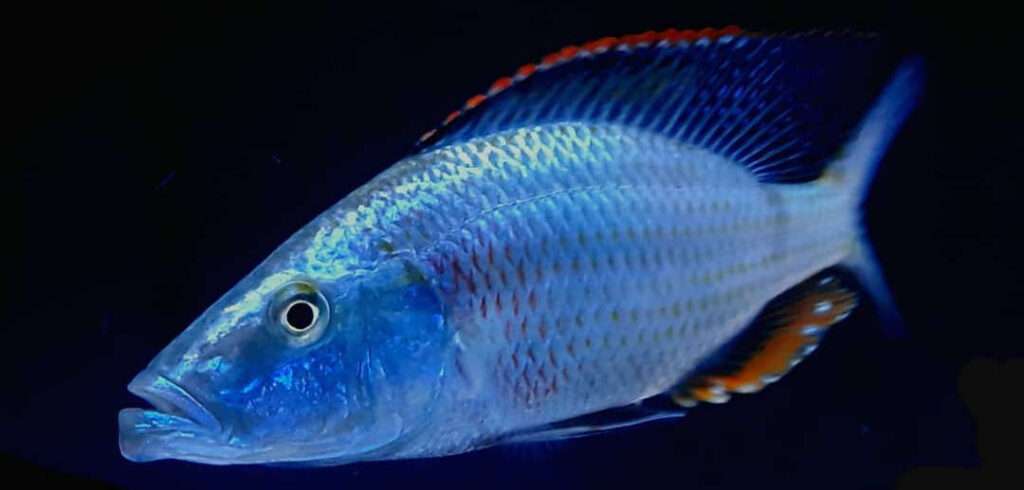
Size
A pair of Dimidiochromis compressiceps measures around 23 centimeters in length when completely mature (9.1 in).
Physical Characteristics and Behavior
Males frequently have bigger body sizes than females do. The Latin word compressiceps describes the body’s lateral compression and narrowing, which makes it challenging to view. Nearly a third of the length of the body is made up of the length of the jaws and mouth together. Its body is typically silvery white with a brown horizontal stripe extending from its nose to its tail, making this large and exquisite cichlid stand out. Males change their color pattern to a metallic blue with vivid red and orange accents on their fins when they reach sexual maturity.
Habitat
They need a habitat where the water is between 73- and 86 degrees Fahrenheit (22.8 and 30 degrees Celsius), 7.7 and 7.6 on the pH scale, and 6 and 10 on the dGH scale. A 125-gallon (473-liter) tank is the bare minimum for a solitary fish or a small harem.
In Captivity

- Care of Aquariums
Insufficient water quality will lead to the decline of Malawi cichlids. Do water changes of 20 to 50% per week, depending on bio load, as these fish are filthy. Malawi bloat is a common illness, particularly if their nutritional demands are not satisfied with high-quality diets.
Weekly Water Changes: Depending on the bio load, weekly water changes of 20–50% are advised.
- Setup of an Aquarium
Lake Malawi receives its water from streams that are rich in minerals. Alkaline water that is heavily mineralized is the result of this combined with evaporation. In terms of pH and other water chemistries, Lake Malawi is renowned for its transparency and stability. It is simple to understand why it is crucial to keep an eye on tank parameters when using any Lake Malawi fish.
Brackish waters are not home to rift lake cichlids because they require hard, alkaline water. Sometimes salt is added to water to improve the carbonate hardness as a buffering agent. This cichlid may be kept in slightly brackish water because it has some salt tolerance. However, it is not appropriate for a brackish water tank that is completely full. It can withstand a specific gravity of less than 1.0002 and a salinity of around 10% of a typical saltwater tank.
For a single fish or a small harem, a tank with a minimum capacity of 125 gallons is required. They require a tank that can accommodate their frequent bursts of speed. If kept in a tank with other cichlids, a bigger tank will be required. They can survive in freshwater or brackish freshwater, but they require strong and effective filtration as well as good water movement. They can live in any pH level that is higher than neutral, however 8 is the ideal.
They prefer a sand or fine gravel substrate. It is possible to utilize freshwater or saltwater fish sand, which can help maintain a high PH. In addition to raising the water’s carbonate hardness, crushed coral or aragonite sand tends to dissolve more readily than salts. However, keeping a higher pH makes ammonia more deadly, thus regular water changes are essential for these fish.
- A minimum 125 gallon (473 litre) tank is required for a single fish or a small harem; a larger tank is required if other cichlids are kept with it.
- Appropriate for Nano Tank: No
- Substrate: Sand/gravel mixture
- Low-intensity, subtle lighting is required.
- 73.0 to 86.0 degrees Fahrenheit (22.8 to 30.0 degrees Celsius)
- pH Range: 7.7-8.6
- Range of hardness: 6 to 10 dGH
- Brackish: Occasionally – They do not naturally encounter salt, although they do have a small tolerance to it. Keep levels below 10%, or less than 1.0002 in terms of specific gravity.
- Moderate water movement
- Center Water Region: These fish will move around the aquarium’s middle and bottom.
- Feeding and Food
The food of the Malawi Eyebiter, an omnivore and piscivore, consists primarily of small bony fish. Any fish that is half its size or smaller will undoubtedly be killed and eaten by them. It is not required to feed live feeder fish, as doing so will increase aggression in cichlids in general. Silversides, lancetfish, prawns, cockles, mussels, and other shellfish, as well as various green vegetables, may be fed to them.
Change their nutrition, and you’ll get gorgeous colors in return. To help prevent Malawi bloat, they do really require some vegetable matter. The infants can be fed blood worms (mosquito larvae), but as they become older, they need larger feeds. They can also be fed frozen cichlid food or pellets with a high protein content. Your Malawi Eyebiter will remain in top shape if you maintain a healthy diet and take vitamins. When housing certain cichlids with Malawi Eyebiters, take in mind that certain of them cannot consume beef heart.
Table





